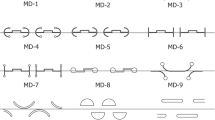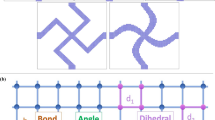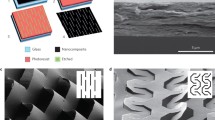Abstract
Kirigami, as an ancient Japanese paper-cutting and origami art, has been widely used in the study of tensile properties of 2D nanomaterials. Diamane—a 2D nanodiamond film—has excellent electrical, thermal, and mechanical properties, while its ductility is poor, so this paper focuses on the enhancement of the tensile properties of Diamane by Kirigami. In this study, the tensile mechanical properties and deformation mechanisms of Diamane Kirigami were simulated and analyzed using molecular dynamics by varying three geometrical parameters, namely, the degree of overlap, the cutting rate, and the aspect ratio of the Kirigami cuts. The results show that the fracture strain (200–250%) of Diamane Kirigami can be 7–8 times higher than that of pristine Diamane (zigzag: 26.1%, armchair: 17.6%). For Diamane Kirigami in the armchair chiral configuration, more stable mechanical properties and ductility can be obtained in all parameters of the design. The I-shaped cutout shape and the stretching in the armchair direction can help Diamane Kirigami to significantly reduce the stress concentration at the ends of the cut and to increase the fracture strain. In conclusion, it is found in this paper that Diamane Kirigami possesses higher fracture strain compared to pristine Diamane, which will potentially expand their applications in engineering nanodevices and nanoelectronics.















Similar content being viewed by others
References
Sofo JO et al (2007) Graphane: a two-dimensional hydrocarbon. Phys Rev B. https://doi.org/10.1103/PhysRevB.75.153401
Chernozatonskii LA, Sorokin PB, Kvashnin AG et al (2009) Diamond-like C2H nanolayer, diamane: simulation of the structure and properties. JETP Lett 90(2):134–138. https://doi.org/10.1134/s0021364009140112
Martins LGP, Silva DL, Smith JS et al (2019) Evidence for a pressure-induced phase transition of few-layer graphene to 2D diamond. arXiv preprint arXiv:1910.01591. https://doi.org/10.48550/arXiv.1910.01591
Ke F, Zhang L, Chen Y et al (2019) Synthesis and electronic structure characterization of diamane. arXiv preprint arXiv:1902.01570. https://doi.org/10.48550/arXiv.1902.01570
Sorokin PB, Yakobson BI (2021) Two-dimensional diamond-diamane: current state and further prospects. Nano Lett 21(13):5475–5484. https://doi.org/10.1021/acs.nanolett.1c01557
Bakharev PV, Huang M, Saxena M et al (2020) Chemically induced transformation of chemical vapour deposition grown bilayer graphene into fluorinated single-layer diamond. Nat Nanotechnol 15(1):59–66. https://doi.org/10.1038/s41565-019-0582-z
Piazza F, Gough K, Monthioux M et al (2019) Low temperature, pressureless sp2 to sp3 transformation of ultrathin, crystalline carbon films. Carbon 145:10–22. https://doi.org/10.1016/j.carbon.2019.01.017
Zhu L, Li W, Ding F (2019) Giant thermal conductivity in diamane and the influence of horizontal reflection symmetry on phonon scattering. Nanoscale 11(10):4248–4257. https://doi.org/10.1039/c8nr08493a
Wu Y-C, Shao J-L, Zheng Z et al (2020) Mechanical properties of a single-layer diamane under tension and bending. J Phys Chem C 125(1):915–922. https://doi.org/10.1021/acs.jpcc.0c08172
Muniz AR, Machado AS, Maroudas D (2015) Mechanical behavior of interlayer-bonded nanostructures obtained from bilayer graphene. Carbon 81:663–677. https://doi.org/10.1016/j.carbon.2014.10.003
Niraula PR, Cao T, Bongiorno A (2020) Mechanical properties of sp3-bonded carbon and boron nitride 2D membranes: a first principles study. Comput Mater Sci 179:109635. https://doi.org/10.1016/j.commatsci.2020.109635
Samarakoon DK, Wang XQ (2010) Tunable band gap in hydrogenated bilayer graphene. ACS Nano 4(7):4126–4130. https://doi.org/10.1021/nn1007868
Mortazavi B, Shojaei F, Javvaji B et al (2020) First-principles investigation of mechanical, electronic and optical properties of H-, F- and Cl-diamane. Appl Surf Sci 528:147035. https://doi.org/10.1016/j.apsusc.2020.147035
Si C, Sun Z, Liu F (2016) Strain engineering of graphene: a review. Nanoscale 8(6):3207–3217. https://doi.org/10.1039/c5nr07755a
Qi Z, Campbell DK, Park HS (2014) Atomistic simulations of tension-induced large deformation and stretchability in graphene kirigami. Phys Rev B 90(24):245437. https://doi.org/10.1103/PhysRevB.90.245437
Kumar S, Mishra T, Mahata A (2020) Manipulation of mechanical properties of monolayer molybdenum disulfide: kirigami and hetero-structure based approach. Mater Chem Phys 252:123280. https://doi.org/10.1016/j.matchemphys.2020.123280
Han T, Scarpa F, Allan NL (2017) Super stretchable hexagonal boron nitride kirigami. Thin Solid Films 632:35–43. https://doi.org/10.1016/j.tsf.2017.03.059
Cai J, Estakhrianhaghighi E, Akbarzadeh A (2022) Functionalized graphene origami metamaterials with tunable thermal conductivity. Carbon 191:610–624. https://doi.org/10.1016/j.carbon.2022.02.008
Tang Y, Yin J (2017) Design of cut unit geometry in hierarchical kirigami-based auxetic metamaterials for high stretchability and compressibility. Extreme Mech Lett 12:77–85. https://doi.org/10.1016/j.eml.2016.07.005
Plimpton S (1995) Fast parallel algorithms for short-range molecular dynamics. J Comput Phys 117(1):1–19. https://doi.org/10.1006/jcph.1995.1039
Stukowski A (2010) Visualization and analysis of atomistic simulation data with OVITO–the open visualization tool. Model Simul Mater Sci Eng 18(1):015012. https://doi.org/10.1088/0965-0393/18/1/015012
Zhao D, Wang J, Hao P et al (2021) A molecular dynamics simulation on the atomic mass sensor made of monolayer diamond. Nanotechnology. https://doi.org/10.1088/1361-6528/ac1d0a
Zhang Z, Cai K, Wang L (2023) Configuration defects-induced energy loss of a self-shrinking nanonetwork under cyclic biaxial stretching-shrinking. Comput Mater Sci 227:112280. https://doi.org/10.1016/j.commatsci.2023.112280
Cai K, Zhang Z, Wang L (2022) Energy evolution mechanism of nanonetwork from hydrogenated graphene scrolls. Mater Today Commun 33:104957. https://doi.org/10.1016/j.mtcomm.2022.104957
Blees MK, Barnard AW, Rose PA et al (2015) Graphene kirigami. Nature 524(7564):204–207. https://doi.org/10.1038/nature14588
Barboza AM, Aliaga LC, Faria D et al (2022) Bilayer graphene kirigami. Carbon Trends 9:100227. https://doi.org/10.1016/j.cartre.2022.100227
Cai J, Akbarzadeh A (2021) Hierarchical kirigami-inspired graphene and carbon nanotube metamaterials: tunability of thermo-mechanic properties. Mater Des 206:109811. https://doi.org/10.1016/j.matdes.2021.109811
Zheng Z, Zhan H, Nie Y et al (2020) Single layer diamond-a new ultrathin 2D carbon nanostructure for mechanical resonator. Carbon 161:809–815. https://doi.org/10.1016/j.carbon.2020.02.017
Zheng B, Gu GX (2019) Tuning the graphene mechanical anisotropy via defect engineering. Carbon 155:697–705. https://doi.org/10.1016/j.carbon.2019.09.008
Cheng T, Liu Z, Liu Z (2020) High elastic moduli, controllable bandgap and extraordinary carrier mobility in single-layer diamond. J Mater Chem C 8(39):13819–13826. https://doi.org/10.1039/d0tc03253k
Bacon R (1960) Growth, structure, and properties of graphite whiskers. J Appl Phys 31(2):283–290. https://doi.org/10.1063/1.1735559
Author information
Authors and Affiliations
Corresponding author
Ethics declarations
Conflict of interest
The authors declare no competing interests.
Additional information
Publisher’s note
Springer Nature remains neutral with regard to jurisdictional claims in published maps and institutional affiliations.
Rights and permissions
Springer Nature or its licensor (e.g. a society or other partner) holds exclusive rights to this article under a publishing agreement with the author(s) or other rightsholder(s); author self-archiving of the accepted manuscript version of this article is solely governed by the terms of such publishing agreement and applicable law.
About this article
Cite this article
Zhu, P., Wang, S., Zhang, X. et al. Mechanical properties of diamane kirigami under tensile deformation. J Nanopart Res 26, 91 (2024). https://doi.org/10.1007/s11051-024-06004-4
Received:
Accepted:
Published:
DOI: https://doi.org/10.1007/s11051-024-06004-4




